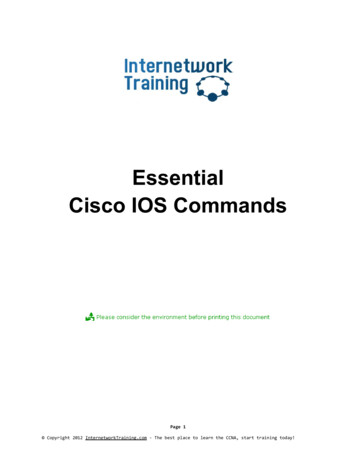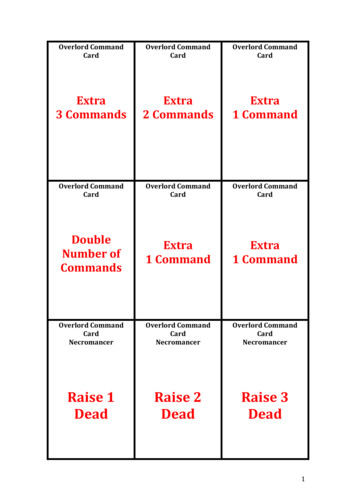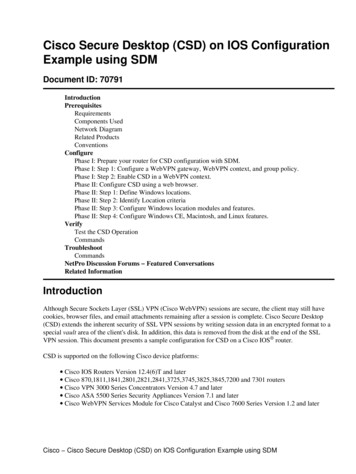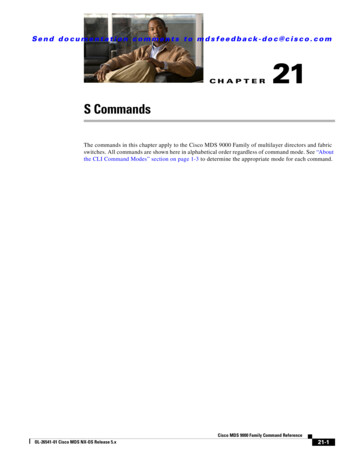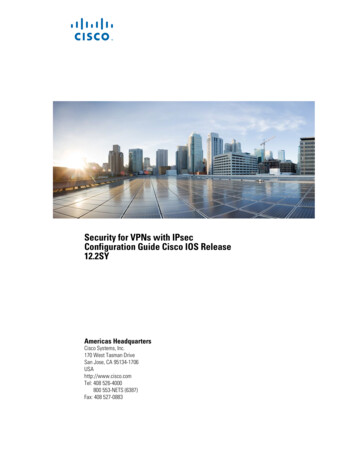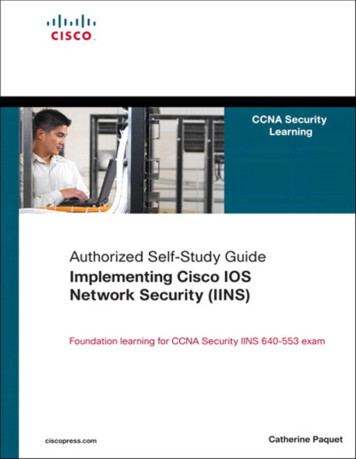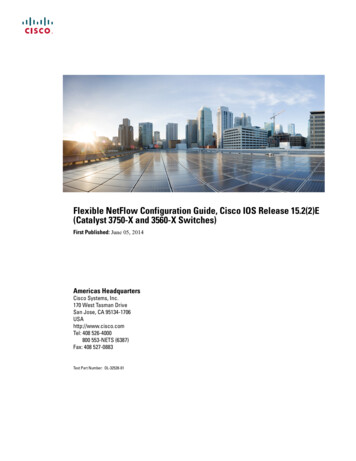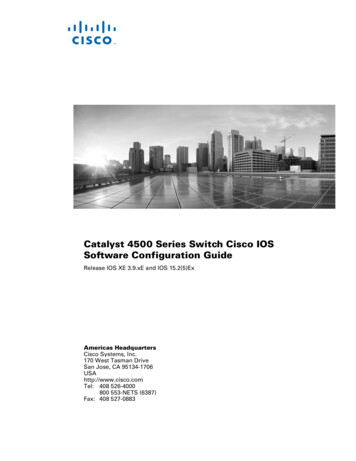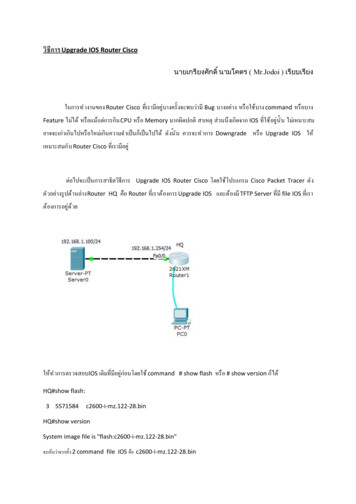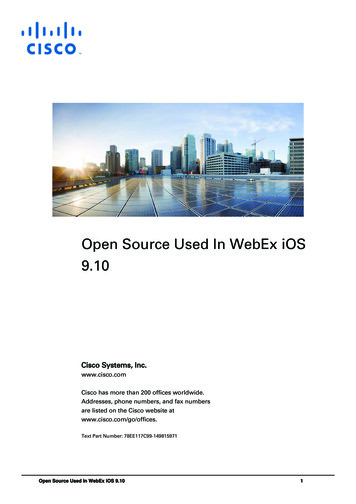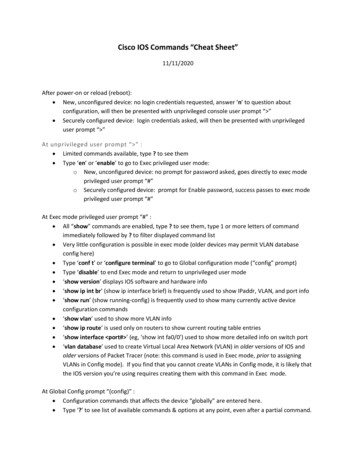
Transcription
Cisco IOS Commands “Cheat Sheet”11/11/2020After power-on or reload (reboot): New, unconfigured device: no login credentials requested, answer ‘n’ to question aboutconfiguration, will then be presented with unprivileged console user prompt “ ” Securely configured device: login credentials asked, will then be presented with unprivilegeduser prompt “ ”At unprivileged user prompt “ ” : Limited commands available, type ? to see them Type ‘en’ or ‘enable’ to go to Exec privileged user mode:o New, unconfigured device: no prompt for password asked, goes directly to exec modeprivileged user prompt “#”o Securely configured device: prompt for Enable password, success passes to exec modeprivileged user prompt “#”At Exec mode privileged user prompt “#” : All “show” commands are enabled, type ? to see them, type 1 or more letters of commandimmediately followed by ? to filter displayed command list Very little configuration is possible in exec mode (older devices may permit VLAN databaseconfig here) Type ‘conf t’ or ‘configure terminal’ to go to Global configuration mode (“config” prompt) Type ‘disable’ to end Exec mode and return to unprivileged user mode ‘show version’ displays IOS software and hardware info ‘show ip int br’ (show ip interface brief) is frequently used to show IPaddr, VLAN, and port info ‘show run’ (show running-config) is frequently used to show many currently active deviceconfiguration commands ‘show vlan’ used to show more VLAN info ‘show ip route’ is used only on routers to show current routing table entries ‘show interface port# ’ (eg, ‘show int fa0/0’) used to show more detailed info on switch port ‘vlan database’ used to create Virtual Local Area Network (VLAN) in older versions of IOS andolder versions of Packet Tracer (note: this command is used in Exec mode, prior to assigningVLANs in Config mode). If you find that you cannot create VLANs in Config mode, it is likely thatthe IOS version you’re using requires creating them with this command in Exec mode.At Global Config prompt “(config)” : Configuration commands that affects the device “globally” are entered here. Type ‘?’ to see list of available commands & options at any point, even after a partial command.
“Show” commands are not directly available in global config mode; however, most “show”commands can be performed by preceding them with ‘do’, conveniently eliminating need todrop out of config mode back to exec mode and back.Type ‘end’ (or keys Ctrl z) to end config mode and return to Exec mode.Typing any command (besides “do” or “?”) in Global config mode typically takes you to a subconfig mode; type ‘exit’ (or keys Ctrl z) when in a sub-config mode to return back to Globalconfig mode.‘enable secret password ’ (eg, ‘enable secret C0nf1dent!al’) sets a password required to enterExec privileged user mode, where MD5 Hash is calculated and stored in running-config.‘username name secret password ’ Adds users and credentials to a table of authorizedusers, which can be referenced via “local” option in “line” configuration commands. Use ofoptional ‘secret’ parm causes the password to be hashed using MD5, and the hash value isstored in the table instead of the clear password, improving device security.‘login local’ when in console or VTY sub-config mode causes the user to be prompted forusername and password that is stored in the user credentials table (see ‘user’ command above).‘banner motd delimiter character ’ (eg, ‘banner motd ’ ) when in global config mode allowsfor the creation of a “message of the day” that is displayed upon first connection to the consoleor virtual teletype terminal user mode, before entering exec mode. The delimiter character canbe any ASCII keyboard character, and is used to tell IOS when the banner message text beginsand ends (for this reason, a rarely used character is recommended such as the plus or vertical bar or % percentage symbol (the delimiter character must not be used within thebanner message text, as IOS will truncate the message when it is encountered). Type motd isthe most common banner message type used to warn device users against performingunauthorized access, use, or changes to the device, but additional warnings can be set using‘banner exec’ and/or ‘banner login’.‘hostname text string for name ’ (eg, ‘hostname SDCswitch1’ changes name of switch to“SDCswitch1”) when in global config mode sets the name of the device to admin user specifiedtext string, for ease in identifying the device in a multiple host device network.‘no ip domain-lookup’ when in global config mode, causes the device to not attempt to contacta DNS server when it does not recognize certain misspelled commands and then wait for aresponse, which can take minutes during which time the device command line is essentiallyfrozen. This is a convenience option for the administrator user configuring the device. Thiscommand is only valid on Cisco routers and Layer 3 switches.‘logging synchronous’ when in line con 0 sub-config mode, causes the device to not interruptcommand entry when the device displays log update information. Default behavior of IOS is toimmediately display certain status information to the user (that is being written to the log),which often occurs while the admin user is typing CLI commands and thereby interruptscommand input for a moment; this can be irritating, so disabling this behavior is a commonpractice.
‘line vty 0-15’ enters sub-config for virtual teletype (TTY) consoles used for remote managementaccess into device. Recommended to use available commands there to secure remote access,eg ‘login’ to require usernames & passwords, require SSH, etc.‘line con 0’ (‘line console 0’) enters sub-config for device console that is displayed either viaConsole port, Aux port, or VTY ports. Recommended to use available commands there to secureaccess, eg ‘login’ to require usernames & passwords.‘interface port number ’ (eg, ‘int fa0/1’) is frequently used to enter interface subconfiguration mode for a hardware port or VLAN to set IPaddr, mask, VLAN assignment, mode,port speed and more.‘switchport mode access’ in interface sub-config mode on a Cisco switch sets the hardwareinterface port for access mode only, recommended for security hardening since default isdynamic mode that allows a malicious user to automatically connect in trunk mode to facilitatea man-in-the-middle (MITM) exploit.‘switchport mode trunk’ in interface sub-config mode on a Cisco switch sets the interface portfor trunk mode, so that it can be used to support multiple VLANs when connecting to anotherswitch or router port that is also configured as a trunk port.‘no shutdown’ when in interface sub-config mode causes the port, or range of ports, to becomeoperational; this is reflected in the pertinent show ip interface brief command displaying theprotocol for the port(s) as “up”.‘ip route outside network IPaddr outside subnet mask next hop gateway, or outsideinterface ’ (eg, ‘ip route 172.16.0.0 255.255.0.0 192.168.0.1’) places a static route into theRouting Table of a router (or Layer 3 switch), so that the router knows where to fwd TCP/IPpackets for outside (non-directly connected) networks‘ip route 0.0.0.0 0.0.0.0 next hop gateway, or interface ’ (eg, ‘ip route 0.0.0.0 0.0.0.0 fa0/0’)places a “gateway of last resort” route into the Routing Table of a router, essentially setting adefault gateway route for all unknown destination networks. Also, see “default gateway”configuration command which is similar.‘ip domain-name name ’ (eg, ‘ip domain-name kangas.com’) in global config mode assigns adomain name to a router (or certain managed switches), which is required for generating cryptokeys for device remote access by SSH and other purposes.‘encapsulation dot1q’ sets a switch or router interface to use the open standard 802.1Qtrunking protocol when setting up a switch or router to do virtual local area networks VLANs.Both devices connected via trunk mode ports should be set to use this protocol as it offersbenefits over the older proprietary Cisco trunking protocol that most Cisco devices default to.‘crypto key generate rsa modulus length ’ (eg, ‘crypto key generate rsa modulus 1024’)causes IOS to create encryption keys, commonly used for remote device access via SSH andother purposes. The IOS being used must have a license enabling this functionality. Crypto keyis required before configuring VTY shells for access via SSH (not required for telnet).
Basic Cisco Router ConfigurationFirst, after entering privileged (exec) user mode, set ‘hostname’, ‘enable secret password ’, ‘no ipdomain-lookup’, ‘motd’, ‘logging synchronous’ as you would for a Cisco switch. Router security is evenmore important than for a switch.1. ‘line con 0’ in global config mode enters sub-mode for configuring the administrator console(what you are in right now).2. ‘password password ’ (eg, ‘password CiscoAdmin’) while in console line sub-config mode setsa user specified password required for logging into the admin console.3. ‘login’ while in console sub-config mode turns on user challenge for credentials.4. ‘motd-banner’ while in console line sub-config mode enables the display of the MOTD banner(previously configured during global terminal config mode) upon user connection to the lineconsole before login.5. ‘logging synchronous” while in console line sub-config mode prevents the router frominterrupting the user’s entry of commands whenever the router enters information into itsdevice log.6. ‘exit’ returns to global config mode (from console line sub-config mode)7. ‘line vty 0 4’ in global config mode enters sub-mode for configuring Virtual TeletYpe adminconsoles. VTY consoles are used for administering the router from a remote network location,as opposed to the physical console port on the router. In this case, all available default consoleline numbers 0 through 4 will be configured simultaneously, which is highly recommended in theinitial configuration. If only one console line number is to be configured or changed, specify justthat one console line in the command (eg, ‘line vty 2’).8. ‘password password ’ (eg, ‘password CiscoAdmin’) while in console line sub-config mode setsa user specified password required for logging into the consoles.9. ‘login’ while in console line sub-config mode turns on user challenge for credentials.10. ‘transport input ssh’ while in console line sub-config mode sets input connection protocolrequired to SSH for more secure encrypted communications. Remember, that VTY consoles areaccessed from a remote network location, therefore are more vulnerable to attack, so using SSHprotocol to connect to them is a best practice.11. ‘motd-banner’ while in console line sub-config mode enables the display of the MOTD bannerupon user connection to a line console before login.12. ‘exit’ returns to global config mode (from console line sub-config mode)13. ‘interface port number ’ (eg, ‘int gig0/0’) while in global config mode, enters sub-config modefor the specified interface port.14. ‘ip addr IP address subnet mask ’ (eg, ‘ip addr 192.168.100.1 255.255.255.0’) while ininterface sub-config mode, assigns a subnetwork gateway IP address to the port. This definesthe subnetwork for hosts connected to that port.15. ‘description text string label ’ (eg, ‘description FinanceDept’) while in interface sub-configmode causes a descriptive label to be assigned to that particular port, which aids admins
16.17.18.19.20.21.working with a network topology, similar to how a custom hostname helps. Note: this isoptional, not required for router operation.‘no shut’ while in interface sub-config mode, turns on the port (by default, the port is shutdownon a new router).‘exit’ returns user to global config mode.Repeat steps 7-11 for other interfaces in use. Set all other UNused ports to ‘shutdown’ as a bestsecurity practice to help prevent an attacker from using them.‘ip route destination subnetwork address subnet mask next neighbor router hop IPaddress OR interface port number ’ (eg, ‘ip route 192.168.50.0 255.255.255.0 172.16.0.1’, OR‘ip route 192.168.50.0 255.255.255.0 gig0/0’) while in global config mode enters a static routeinto the routing table, to a tell the router where to forward packets that fall into the specifiedsub-network address range and that are in a subnetwork not directly connected to this router.Typically, the specified subnetwork is in another area within the organization connected to adifferent router. “Static” routes are used when dynamic router protocol is not in use (default),and typically have the benefits of faster performance and improved security, but are oftenadministrator labor intensive.‘ip route 0.0.0.0 0.0.0.0 next neighbor router hop IP address OR interface port number ’ (eg,‘ip route 0.0.0.0 0.0.0.0 172.16.0.1’ OR ‘ip route 0.0.0.0 0.0.0.0 gig0/1’) while in global configmode, enters a DEFAULT static route into the routing table. When the router receives a packetit first looks into its routing table for a match, if it does not find a match it then looks to see ifthere is a default route (specified by IP address 0.0.0.0 and subnet mask 0.0.0.0), but if it doesnot find a default match it throws the packet away. Use of default routes in a network dependsupon network topology and other concerns.‘copy running-config startup-config’ writes the current running configuration, in RAM, to thestartup configuration, in non-volatile memory, so that it persists through a reboot or powercycle.
Basic Cisco Switch Configuration, including SecurityFirst, after entering privileged (exec) user mode, set ‘hostname’, ‘enable secret password ’, ‘motd’,‘logging synchronous’, (and ‘no ip domain-lookup’ if it is a Layer3 switch). as you would for a Ciscorouter. Switch security is important to defeat a number of targeted attacks.1. ‘line con 0’ in global config mode enters sub-mode for configuring the administrator console(what you are
Cisco IOS Commands Cheat Sheet _ 11/11/2020 After power-on or reload (reboot): . ‘switchport mode trunk’ in interface sub-config mode on a Cisco switch sets the interface port for trunk mode, so that it can be used to support multiple VLANs when connecting to another switch or router port that is also configured as a trunk port. Zno shutdown when in interface sub-config mode .
